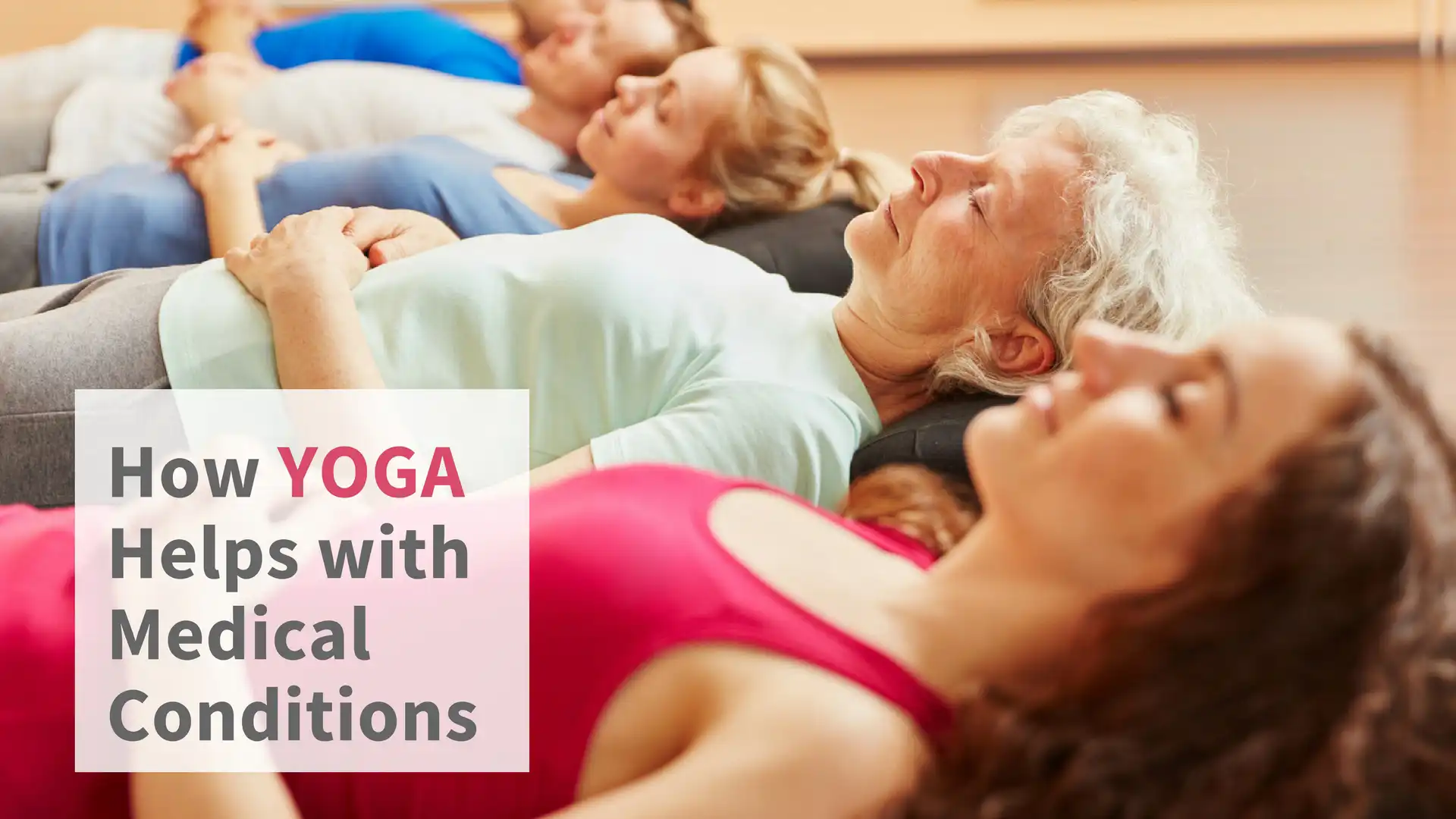Yoga as Therapy: How to Target Your Yoga Practice for Prevention

Practicing yoga enhances our health in many ways. There are three specific avenues through which yoga practice affects our physical, mental and emotional health: 1. prevention, 2. symptom improvement, and 3. as an adjunct to other forms of treatment.
Preventative Yoga
Today, I want to discuss what we mean by “prevention.” To put it simply, this means you are using yoga to:
1. Prevent diseases or conditions from developing.
2. Prevent a disease or condition that you already have from getting worse.
Now let’s take a closer look at both of these ways you can use yoga for prevention.
How Yoga Prevents Diseases or Conditions from Developing
One valuable way you can use yoga for prevention is to promote your overall health in general. Yoga is particularly effective for this because a well-rounded yoga practice that includes an active asana practice, stress management practices, and equanimity practices can help prevent diseases and conditions caused by sedentary behavior and/or chronic stress, such as obesity, heart diseases, cancer, and diabetes.
Because a well-rounded asana practice includes active strength, flexibility, balance and agility practices, yoga can also help prevent problems related to being sedentary, including osteoporosis, sarcopenia, balance problems, and falls. And yoga’s stress management practices are good preventative medicine for fostering good emotional and mental health, at the same time they help foster physical health.
Another valuable way to use yoga for prevention is to focus on preventing a particular disease or condition that you’re concerned about. For example, if you have risk factors for osteoporosis, you can emphasize strength practices to build both bone and muscle strength. Or, if you have cardiovascular diseases running in your family, you can emphasize cardiovascular health practices to prevent the development of high blood pressure, heart attacks, strokes, irregular heart rhythms, and congestive heart failure.
How Yoga Prevents Diseases or Conditions from Getting Worse
If you already have a medical condition, depending on the type of condition, you may be able to focus on preventing it from progressing further. Yoga is particularly beneficial for conditions that benefit from working on physical skills, cardiovascular practices, and stress management. In general, some conditions that yoga can help prevent from getting worse include: osteopenia, osteoporosis, sarcopenia, arthritis, diabetes, and high blood pressure.
 Here are a few examples of how it works: If you have sarcopenia of the muscles or osteopenia and osteoporosis of the bones, you can focus on appropriate strength-building practice to hold the condition at bay and in the case of osteopenia prevent it from progressing to osteoporosis and, in some cases, even reversing it somewhat. If you have arthritis, you can focus on flexibility practices to prevent more loss of mobility in your joints, sometimes delaying or maybe even avoiding a joint replacement.
Here are a few examples of how it works: If you have sarcopenia of the muscles or osteopenia and osteoporosis of the bones, you can focus on appropriate strength-building practice to hold the condition at bay and in the case of osteopenia prevent it from progressing to osteoporosis and, in some cases, even reversing it somewhat. If you have arthritis, you can focus on flexibility practices to prevent more loss of mobility in your joints, sometimes delaying or maybe even avoiding a joint replacement.
And if you already have high blood pressure, you can focus on lowering your numbers with asana and stress management practices to prevent it from progressing to heart attack, stroke, irregular heart rhythm, or congestive heart failure.
Yoga and Other Types of Illness Prevention
Keep in mind that yoga alone may not be enough for the best prevention approach. So you may need to combine yoga with other preventive strategies that your family doctor recommends, such as more aerobic activities or special dietary recommendations. But yoga is a great complement to Western medicine. The ultimate goal is your ongoing wellness!
And it is equally important to remember there are no guarantees, and eventually with age and time, we will have to face some serious illness. But it is surely worthwhile to try to delay them in the meantime!
Study with YogaUOnline and Dr. Baxter Bell – Yoga for Your Brain: A New Formula for Healthy Aging
Practice with Baxter Bell, MD – Join him on YogaUOnline’s uniquely resourceful Practice Channel.
Reprinted with permission from Yogaforhealthyaging.blogspot.com
 Baxter Bell, MD, is a yoga teacher and educator, physician and medical acupuncturist. These days he focuses on teaching yoga full time, both to ordinary students of all ages and physical conditions, and to the next generation of yoga teachers, to whom he teaches anatomy and yoga therapy along with his accessible, skillful style of yoga. Baxter brings a unique perspective to his teaching, combining his understanding of anatomy and medicine with his skill at instructing people from all walks of life and all levels of ability. Baxter is the co-founder and writer for the popular Yoga for Healthy Aging blog, where he shares his knowledge of medical conditions, anatomy, and yoga with practitioners and teachers across the world. In addition to being a frequent presenter at Yoga Journal Alive events and yoga conferences such as IAYT’s SYTAR, he is often quoted as an expert on yoga and health by major national news outlets such as The Washington Post and Wall Street Journal. To learn more, visit www.baxterbell.com, www.yogaforhealthyaging.blogspot.com, and his YouTube channel Baxter Bell Yoga.
Baxter Bell, MD, is a yoga teacher and educator, physician and medical acupuncturist. These days he focuses on teaching yoga full time, both to ordinary students of all ages and physical conditions, and to the next generation of yoga teachers, to whom he teaches anatomy and yoga therapy along with his accessible, skillful style of yoga. Baxter brings a unique perspective to his teaching, combining his understanding of anatomy and medicine with his skill at instructing people from all walks of life and all levels of ability. Baxter is the co-founder and writer for the popular Yoga for Healthy Aging blog, where he shares his knowledge of medical conditions, anatomy, and yoga with practitioners and teachers across the world. In addition to being a frequent presenter at Yoga Journal Alive events and yoga conferences such as IAYT’s SYTAR, he is often quoted as an expert on yoga and health by major national news outlets such as The Washington Post and Wall Street Journal. To learn more, visit www.baxterbell.com, www.yogaforhealthyaging.blogspot.com, and his YouTube channel Baxter Bell Yoga.
 Nina Zolotow, RYT 500, Editor-in-Chief of the Yoga for Healthy Aging blog, is both a yoga writer and a yoga teacher. She trained to be a yoga teacher at The Yoga Room in Berkeley, California, has studied yoga therapy with Shari Ser and Bonnie Maeda, and is especially influenced by the teachings of Donald Moyer. She also studied extensively with Rodney Yee, and is inspired by the teachings of Patricia Walden on yoga for emotional healing. Her special area of expertise is yoga for emotional well-being (including yoga for stress, insomnia, depression, and anxiety) and she teaches workshops and series classes on yoga for emotional wellbeing, stress management, better sleep, home practice, and cultivating equanimity. Nina is the co-author, with Rodney Yee, of two books on yoga: Yoga: The Poetry of the Body and Moving Toward Balance, both of which are widely available, and is currently writing a book with Baxter Bell on Yoga for Healthy Aging for publication in 2017.
Nina Zolotow, RYT 500, Editor-in-Chief of the Yoga for Healthy Aging blog, is both a yoga writer and a yoga teacher. She trained to be a yoga teacher at The Yoga Room in Berkeley, California, has studied yoga therapy with Shari Ser and Bonnie Maeda, and is especially influenced by the teachings of Donald Moyer. She also studied extensively with Rodney Yee, and is inspired by the teachings of Patricia Walden on yoga for emotional healing. Her special area of expertise is yoga for emotional well-being (including yoga for stress, insomnia, depression, and anxiety) and she teaches workshops and series classes on yoga for emotional wellbeing, stress management, better sleep, home practice, and cultivating equanimity. Nina is the co-author, with Rodney Yee, of two books on yoga: Yoga: The Poetry of the Body and Moving Toward Balance, both of which are widely available, and is currently writing a book with Baxter Bell on Yoga for Healthy Aging for publication in 2017.



